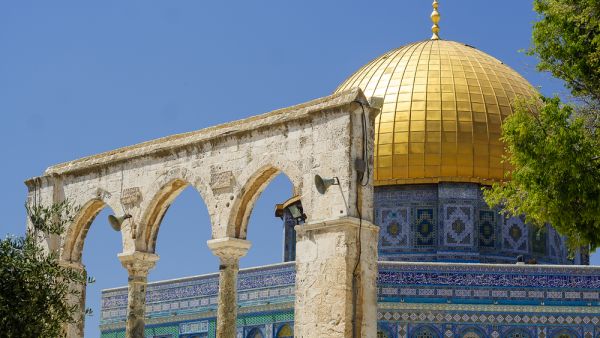The grand and imposing golden dome of Jerusalem’s Al-Aqsa Mosque has long been an enduring symbol of the Holy Land, alternating between an eye-catching focal point for conflict and of faith.
Its outstanding artistry is also a symbol of the wondrous beauties of Islamic art, with its focus on symmetry and form as an act of worship to the divine.
The mosque, however, has also been a symbol of the turbulent times in the Holy Land. In 1969, a religious extremist burnt down the 800-year-old minbar, or pulpit from which religious sermons are given, all but destroying the priceless historic and religious artefact.
The intricate wooden minbar, considered a gem of Islamic art, was constructed in the 12th Century CE, following Jerusalem’s conquest by Saladin, who gave it his name.
The Saladin minbar has since been replaced by a replica, created by a team of highly-skilled artisans from across the Arab region, with vast experience in Arabesque, the style of craftsmanship in which the minbar was created.
The process was not easy, particularly as there were no designs or an integrated model on which work on the minbar could be based.
Daily News Egypt sat down with Magdy El-Adawy, the only Egyptian Arabesque artist to take place in the minbar’s restoration, to talk about the restoration work. He described how the Islamic world almost lost the secrets of this form of art, which is based purely on Islamic scientific and philosophical principles. He also described in detail how he was chosen to take part in the restoration work.
What was the biggest challenge in rebuilding the minbar?
The greatest a challenge faced by the craftsmen and engineers supervising this work was to assemble 16,500 pieces, some of which were no more than a few millimetres in size. The whole platform itself stands at about six metres in length, and it is a really technical piece of building as it was constructed without using glue, nails, or screws. Rather, it was put together using the method of interlocking parts, to produce what could be called art.
The pulpit, which brings together different forms of art, including geometrics, plant decorations, Arabic calligraphy, muqarnas, and inlays of ivory and ebony, interlock the six main forms of Islamic art.
Is there a specific type of wood that is suitable only for Arabesque?
Turning wood is the commonly mistaken among consumers as Arabesque wood, and it consists of wooden grilles which are turned by a special machine. The resulting parts are assembled as interlocking shapes of mashrabiyyas, windows, or other woodwork. The best type for Arabesque work is beech wood, and for large-scale works we use musk wood, among other types.
Has the shape of the lathe (the machine that casts wood) changed over the ages?
Yes, previously the lathe was like a pallet and it was manually worked. The machine was, until recent times, used to make rosary beads. Now, however, with the advent of electricity, fully automatic, electrically driven machines came into use.
This article has been adapted from its original source.








